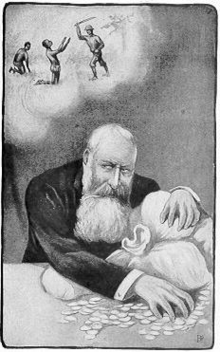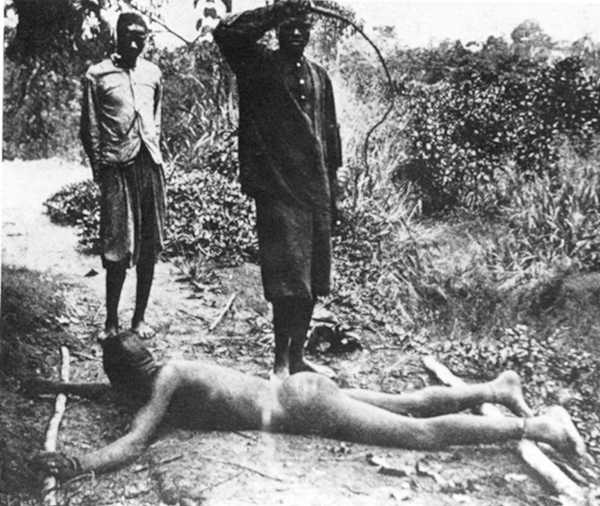David Livingstone:
Exploring the "Dark Continent"

Exploring the Dark Continent
The story of David Livingstone reads like an Indiana Jones movie– without the snake pits. Although there were mummies, Livingstone's mummy to be exact. After finally succumbing to malaria and dysentery his body was salted and dried in the sun to prepare for the 1500 mile journey back to the East African coast.
Livingstone died in 1873 while searching for the source of the Nile River. Livingstone and Stanley were similar in a few important ways. They were both adventures, willing to travel into the heart of the “Dark Continent” (that’s what Europeans called Africa back then, in search of new discoveries and exotic places. At least they were exotic to the Europeans back home who bought their books. To the Africans it was just plain ‘ol home.
In the 1800s Europeans (particularly France and Great Britain) had been doing business–mostly in trading kidnapped people– in Africa since the 1600s. Even longer for Spain and Portugal. However, Europeans stuck to the coast and knew nothing about what lie in the vast interior of the world’s second largest continent. Then David Livingstone comes about, fresh out of medical school at the University of Glasgow, wanting to change the world.

He travels to South Africa as a missionary. Like most European missionaries in those days he saw the Africans in need of saving. Particularly from themselves. He saw the African cultures as primitive and backwards. Most Africans lived in tribal communities, practiced animism (worship of nature) and many still participated in the slave trade. Livingstone traveled to South Africa in 1839 to begin work at converting the native African tribes to Christianity and western civilization.
Some missionaries went about their work trying to transform Africa into a warmer Europe, but not Livingstone. He wanted to not only teach the people about Christianity but also learn as much as he could about local customs and languages. That’s what put him on the path of becoming the world’s most famous 19th century explorer. He set out from South Africa and literally walked across the vast grasslands of Southern Africa (with 100 or so hired African porters carrying hundreds of pounds of supplies).
His objective was to find a suitable place to establish a Christian mission. The journey was packed with danger. Malaria, lions, swollen rivers, vast deserts, rivers filled with temperamental hippopotami (don’t laugh they’re officially the world’s most deadly mammal) killed dozens along the way. Livingstone tried four different places but each one was a failure. Some locations were plagued by malaria (a disease carried by mosquitoes that induces fever and is often fatal); others were too swampy; in other places he was attacked by tribes not all that interested in adopting the ways of whites. However, what he did accomplish would make him a 19th century Indiana Jones.




Exploring the Congo
Within twenty years of Livingstone's death all sorts of characters were literally racing to claim a piece of Africa for their home country. Like a high school football game, each side cheered their ‘team’ on. But of course the prize in this game wasn’t an aluminum trophy and bragging rights. After Livingstone died unexpectedly from malaria on his quest to find the source of the Nile River (it’s a small river in the Ryungwe Forest in Rwanda) his friend Henry Morton Stanley picked up where Livingstone left off.
Stanley didn’t start off as an explorer. In fact, he was a reporter looking to find Livingstone who was said to be lost somewhere in East Africa. Stanley got a lot of attention for this story but he became world famous when he set out to find the source of a river called the Luabala. That’s because what he found was the Congo River, and more importantly a route Europeans could use to get into the interior. It might be a good time for a quick geography lesson. The reason why Africa had remained unseen by European eyes for so long is because much of the continent is either covered in desert or thick rain forest The best way to get around is by boat.
But, well, that can be an even bigger problem.
All of Africa’s major rivers have long stretches that are un-navigable. In some places the water is too shallow. In many places rapids, rocks, and waterfalls keep boats out altogether. Stanley at one point had to disassemble his boat and have it carried over land hundreds of miles to bypass the rapids.

Livingstone traveled back and forth between Britain. He was a national hero. He was the first European to spot Victoria Falls. The locals called it Mosi Oy Tuna ‘The smoke that thunders’ because these waterfalls along the Zambezi River are so mammoth that the water vapor appears to rise like smoke and can be seen from five miles away. He also was the first white man to explore Lake Victoria (the world’s third largest lake). But in 1857, he completed a three year journey that no one thought possible. Literally cutting is way through the thick rain forest of Central Africa and became the first person to cross the African continent (and record the journey) from east to west.
Back home in Britain, Livingstone went on speaking tours and even wrote a best-seller about his adventures. The not so adventurous sounding ‘Missionary Travels and Researches in South Africa’ fired up interest in the Dark Continent. Now other Europeans wanted to go there and see for themselves. Adventurers wanted to make a big name for themselves. Missionaries wanted to set up schools and churches. Abolitionists wanted to end the slave trade that still was being carried on by Portuguese and Arab traders. Of course, everyone paid attention to the vast natural riches that Africa had to offer. The biggest prize was ivory. Dead elephant dentine was in high demand and used by Europeans in everything from fancy carvings to piano keys to even false teeth. Livingstone believed that one way to end the slave trade was to replace Arab traders with European merchants. The idea was to swap the ivory directly for cloth and metal goods that Africans wanted. With the Arab middlemen out of the way, the slave trade would die out. And it did.


"At first, Leopold saw value in missionaries as they encouraged the development of infastructure includung schools to learn European languages and English. However, as the missionaries added civility they also pushed for social justice. No longer useful, Leopold had the exploited missionaries expeled."
http://www.hyperhistory.net
King Leopold's Private Empire
King Leopold II of Belgium was a constitutional monarch, which means he didn’t actually do any ruling. Being power hungry and greedy Leopold decided if he couldn’t rule his own country he would just take over someone else’s.
King Leopold hired Henry Stanley to explore the Congo again but this time with the intention of building a railroad from the Atlantic coast to an inland place past the rapids. There he would build a missionary settlement and trading post. His story was that he wanted to help the Africans with modern medicine and education. His real intention was to become filthy rich and he would go down in the books as one of histories most brutal dictators.
Henry set up a spot along the Congo River called Leopoldville (hey, it’s not a nice name but that’s the name on the paycheck). After years of struggling to build a railroad in a rain forest Leopoldville soon became the capital of a 900,000 mile private estate for a power crazed man. Using a private army of 800 soldiers armed with machine guns and elephant guns Leopold convinced many hostile tribes to sign over their rights to the land and any natural resources.
Leopold immediately outlawed slavery but you would never tell if you had traveled there. The Congo Free State, lasted from 1885 to 1908. During that time Africans were expected to cooperate by supplying Leopold with a steady stream of ivory and rubber. Collecting either of these items is dangerous and back breaking work. Elephants aren't just going to let you walk up and remove their tusk. And while rubber won’t stomp you flat as a pancake, you have to climb 100 foot high trees to tap the liquid found in the vines growing on rubber trees. Rubber trees (Hevea brasiliensis) were brought from the Amazon Rain forest to Central Africa in the 1800s thanks to the demand created by the industrial revolution.
Either task was dangerous and the pay was horrible; just a bolt of cloth and some metal tools or a crate of food. However, back home Leopold and his friends were reaping 700% profits. It doesn’t take an Einstein to tell you that people won’t stick around for long working in dangerous jobs for bad wages. Leopold had a solution for this. He set up a quota system and kidnapped the men’s wives and children. If the men did not meet their quotas they would beat beaten with a strap made of hippopotamus hide called a chicotte, starved, or if they tried to rebel their families could be killed. As Leopold and the investors kept getting richer they also kept getting greedier. Pretty soon children and women were given quotas of collecting rubber sap. White overseers were given bonuses for paying the cheapest price. Some particularly sadistic people resorted to cutting off the hands of those that didn’t meet their quota as a warning to others to work harder.





Test Page
